Key takeaways:
- Green investment funds prioritize companies and projects that focus on environmental sustainability, offering the potential for both financial returns and positive impact.
- Eco-friendly investing promotes a shift in corporate behavior towards sustainability, as investors prioritize environmental responsibility.
- Key factors in selecting green funds include transparency, historical performance, and alignment with personal values.
- Engaging with fund managers and diversifying investments can enhance both the financial and environmental impact of green investments.

Understanding green investment funds
Green investment funds are designed to focus on companies and projects that prioritize environmental sustainability. I remember the first time I delved into this world; it felt like opening a new door to countless possibilities that aligned with my values. It was exciting to think that my investments could contribute to cleaner energy, sustainable agriculture, and other eco-friendly initiatives.
These funds often assess companies based on strict criteria, such as their carbon footprint and overall environmental impact. What I found intriguing is that their performance can rival traditional funds while promoting a beneficial cause. This dual potential always made me ask, why not invest in a way that not only seeks financial returns but also supports the planet?
Furthermore, understanding the specific goals of a green fund is crucial. Some may focus on renewable energy, while others might invest in sustainable real estate. It’s essential to align your values with the fund’s mission. Personally, I learned that digging deeper into a fund’s objectives can illuminate pathways for making conscious choices with my money. How can we truly know if we’re making a difference if we don’t take the time to understand where our investments are going?
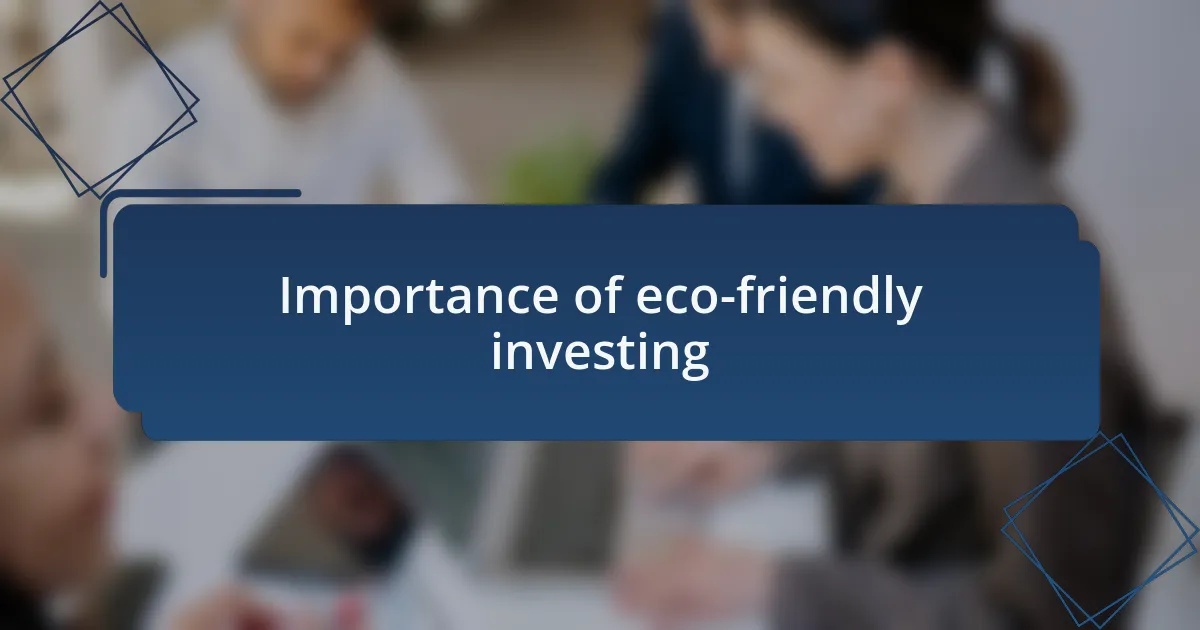
Importance of eco-friendly investing
Investing in eco-friendly funds isn’t just about financial returns; it’s about making a statement and being part of a larger movement. Once, I sat in a meeting where we discussed the impact of climate change. The passion in that room was palpable, and I realized that my investments could actively support solutions rather than contribute to the problem. This connection between financial choices and environmental impact made me see investing in a whole new light.
The importance of eco-friendly investing goes beyond personal values. It’s about aligning with a future where sustainability is the norm, not an exception. I remember when I switched my investment strategy; it felt empowering to support innovations in clean technology and conservation. It’s incredible to think that by choosing green funds, I am not just watching from the sidelines—I’m actively participating in creating a more sustainable world.
Moreover, eco-friendly investments can drive meaningful change in corporate behavior. When companies realize their investors prioritize sustainability, they often adapt their practices to meet these expectations. This shift creates a ripple effect, allowing more businesses to operate in an environmentally conscious manner. Reflecting on my own journey, I can’t help but feel a sense of responsibility—to use my financial influence to encourage companies to do better for our planet. Isn’t it inspiring to consider that our investment choices can help shape a greener tomorrow?
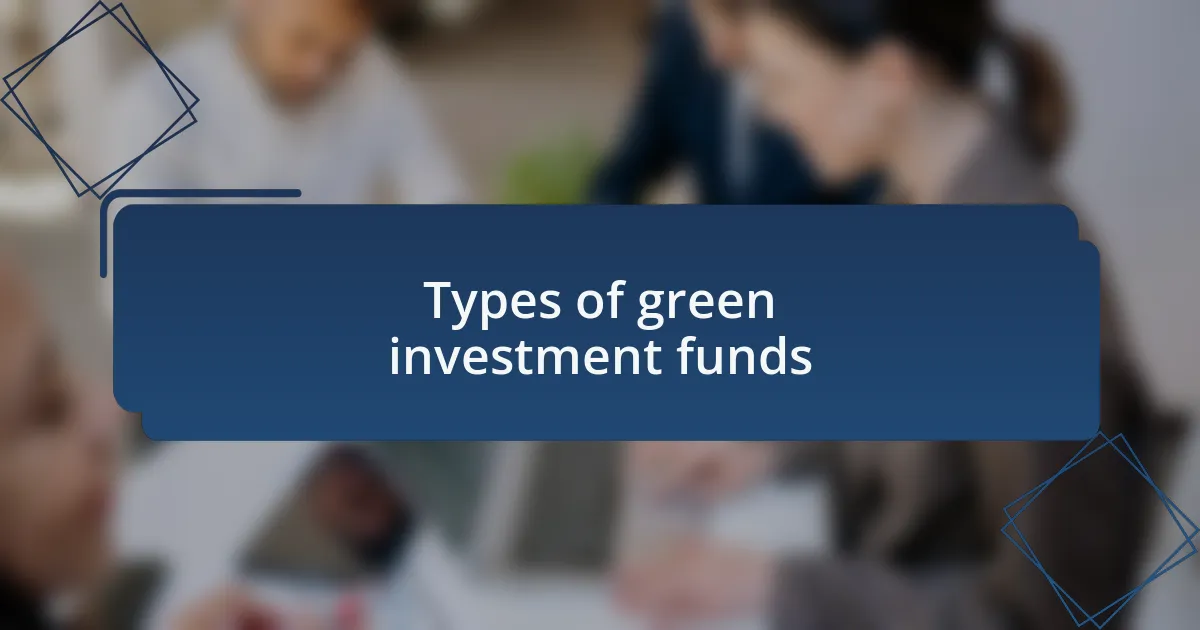
Types of green investment funds
When I first started exploring green investment funds, I was amazed at the variety available. One type that caught my attention is green mutual funds, which pool money from multiple investors to buy shares in companies with strong environmental practices. These funds often focus on sectors like renewable energy, sustainable agriculture, or clean technology. I remember sitting down with my financial advisor, intrigued about how these funds not only diversify my portfolio but also align with my values.
Another fascinating category is exchange-traded funds (ETFs) designed for sustainability. Unlike traditional mutual funds, ETFs trade on exchanges like stocks, providing flexibility for investors. What struck me about these funds was their ability to track various indexes focused on environmental criteria. Have you ever thought about how easily you could adjust your investments according to changing market trends while still supporting clean initiatives? It really opens up avenues for more dynamic investing.
Impact investing funds are equally compelling, as they seek to generate positive social and environmental effects alongside financial returns. These funds actively measure their success based on how well they are making a difference in the world. I was excited to discover this type of fund because it allows me to feel a direct connection to the outcomes of my investments. Isn’t it refreshing to know that my money can contribute to solving real-world problems, like access to clean water or sustainable agriculture?
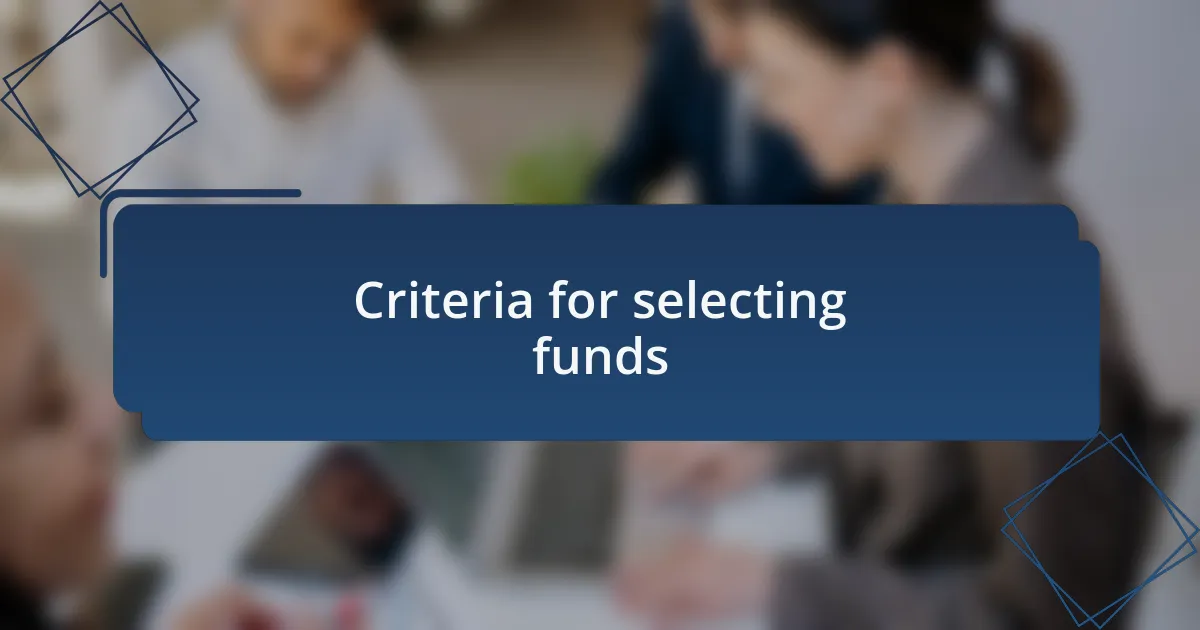
Criteria for selecting funds
When I began my journey into green investment funds, I quickly realized that the specific criteria used to select these funds profoundly impact their potential. First, I always look for transparency in the fund’s objectives and strategy. If I can’t easily find information about how a fund assesses its environmental impact or its investment selection process, it raises red flags for me. Have you ever felt uncertain about where your money is going? That level of uncertainty is something I try to avoid at all costs.
Another important aspect I focus on is the fund’s historical performance. While past performance isn’t a guarantee of future success, it does provide valuable insight into how well the fund has managed its assets. I remember when I was evaluating one particular fund; their strong returns over several years made me feel more confident. It prompted me to think, “If they can achieve this while prioritizing sustainability, it could be a solid investment choice.”
Lastly, the alignment of the fund’s investments with my personal values is crucial in my selection process. I can’t help but feel more invested emotionally when the companies within the fund are ones I genuinely believe are making a positive difference in the world. For instance, I recently chose a fund heavily invested in renewable energy technologies. It reminded me that my financial choices can reflect my beliefs and contribute to a future I desire. How often do we get the chance to align our money with our values?
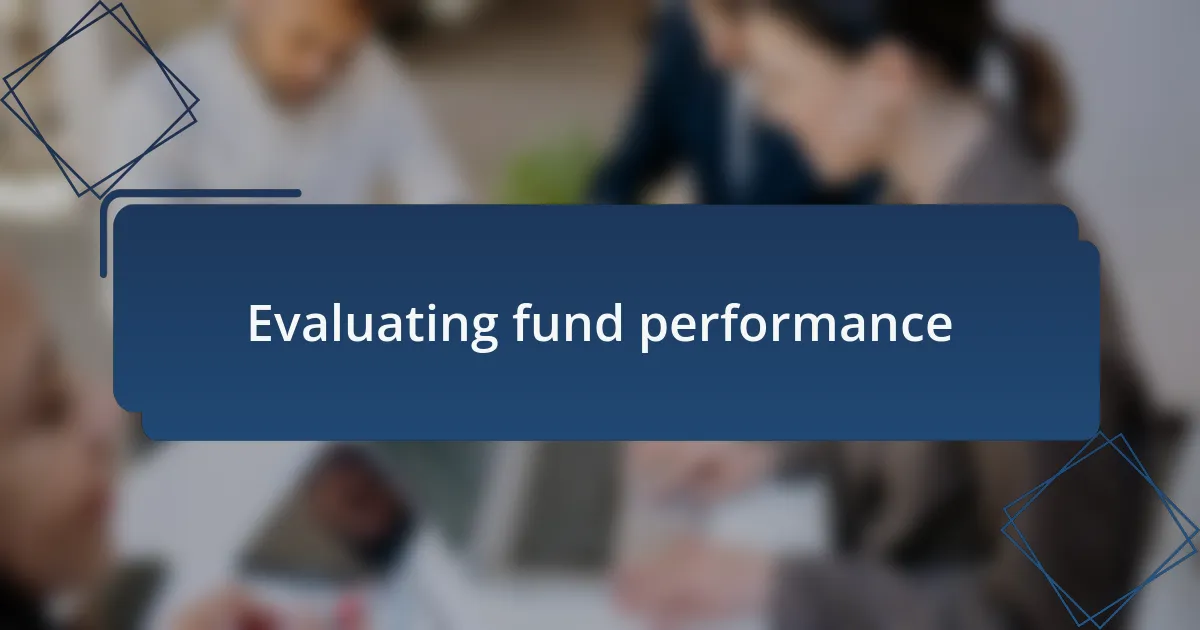
Evaluating fund performance
Assessing how a green investment fund performs goes beyond just looking at numbers; it’s about understanding the fund’s impact. When I evaluate performance, I dive into the qualitative aspects as much as the quantitative ones. For example, I recall one fund that boasted impressive returns, but upon closer inspection, its commitment to environmental initiatives felt more like a marketing ploy than a genuine effort. This experience taught me to scrutinize not just the performance metrics, but also the story behind those numbers. What is the fund truly achieving?
I also pay attention to the fund’s environmental, social, and governance (ESG) ratings, as they offer insights into its sustainable practices. These ratings can provide a clearer picture of how committed the fund is to its green mandate. I remember feeling reassured when I found a fund with high ESG ratings, as it suggested they were not only focusing on profits but also prioritizing positive societal impact. I wondered, isn’t it refreshing to see your investments backed by accountability?
Moreover, I like to compare the fund’s performance against its benchmarks and peers in the green investment space. This approach helps me gauge whether the returns are due to sustainable practices or just market trends. For instance, while evaluating a fund, I was pleased to find it consistently outperformed its counterparts. In that moment, I felt both pride and motivation, knowing my investment choices were contributing to a broader positive change. Could there be a better feeling than seeing your money working towards a sustainable future?
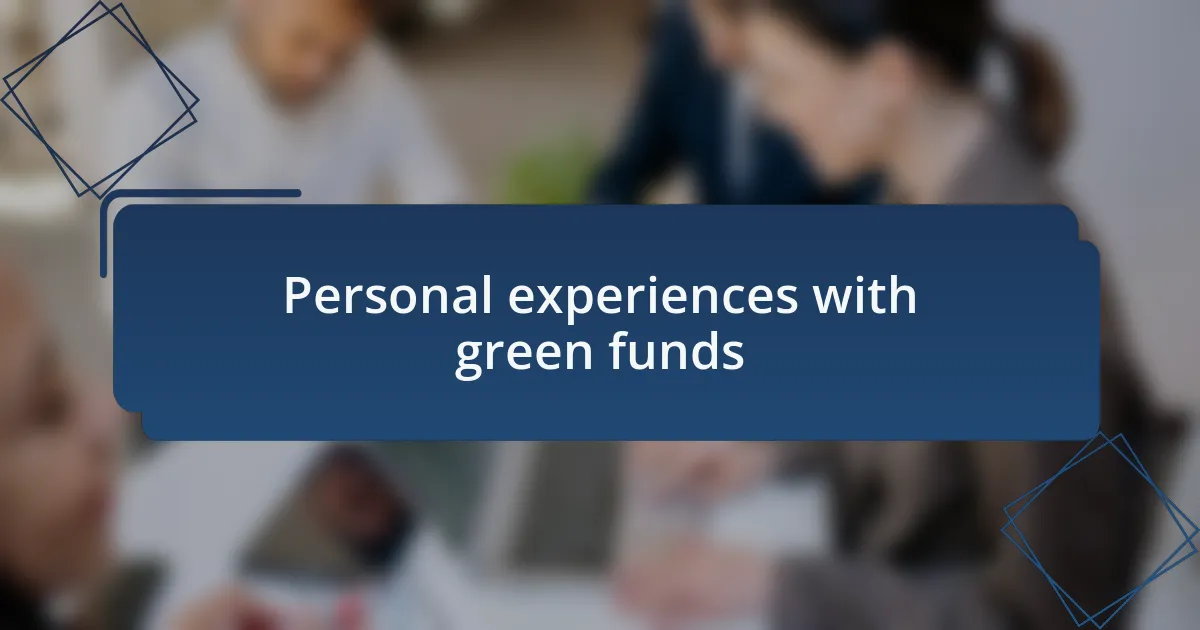
Personal experiences with green funds
When I first ventured into green funds, I remember feeling a mix of excitement and apprehension. I had invested in a renewable energy fund, and at the time, I was anxious about whether my money was truly making a difference. To my delight, not only did I notice a competitive return on my investment, but I also found myself more educated about energy sources and sustainability practices. Watching my investment support clean technologies felt rewarding in ways that traditional funds never had.
On another occasion, I chose to redirect a portion of my retirement savings into a green index fund. I recall the sense of satisfaction I felt during the annual review of my portfolio. As I read through the fund’s impact report, I was moved by stories of communities benefiting from green initiatives. It made me ponder, isn’t it amazing to think my future can intertwine with positive environmental change? This connection deepened my commitment to sustainable investing.
In contrast, there was a moment that served as a wake-up call. I had invested in a fund that advertised its commitment to biodiversity but later learned it still had stakes in companies with poor sustainability records. That experience was disheartening. It made me realize that even in my pursuit of green investments, diligence is crucial. I now understand that environmental claims must be backed by consistent actions. Isn’t it fascinating how investment choices lead us not just to financial outcomes but also to important learning moments?
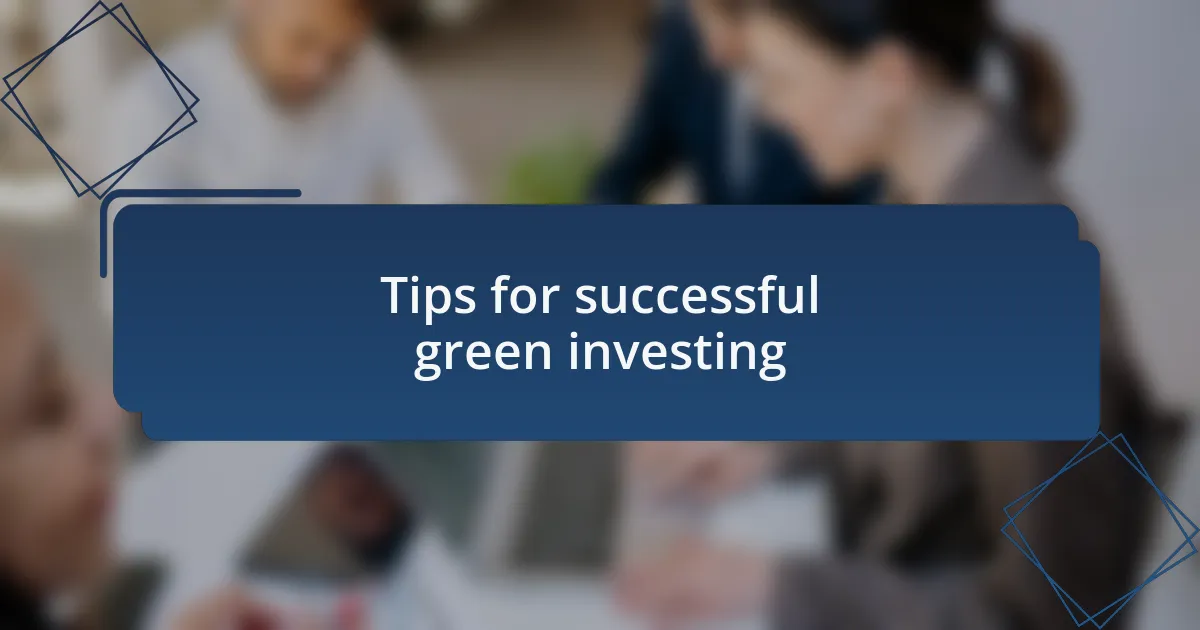
Tips for successful green investing
To succeed in green investing, I’ve found that thorough research is indispensable. When evaluating green funds, I always look at the fund’s ownership and the companies it supports. For example, I remember almost investing in a green fund that seemed promising until I discovered it had significant investments in fossil fuels—this was a real eye-opener for me. Why trust a fund’s green label if its portfolio doesn’t align with sustainability principles?
Engagement with fund managers and understanding their strategies has also been a game changer for me. A few years ago, I attended a webinar where a manager discussed their ESG (Environmental, Social, and Governance) criteria. Hearing firsthand about their commitment to genuine sustainability made me more confident in choosing that fund. Isn’t it reassuring to know the people behind your investments share your values?
Lastly, diversifying within green investments can mitigate risks while amplifying your impact. I personally blend different types of green funds, from solar energy to sustainable agriculture. Recently, I felt a rush of pride when my diversified approach not only weathered market fluctuations but also contributed to multiple positive environmental initiatives. This strategy has reinforced my belief that variety truly enhances both financial stability and meaningful change.